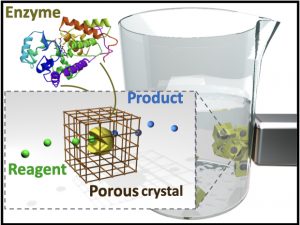Caged enzymes improve biocatalytic processes
|Biocatalysis is a powerful tool that exploits enzymes to perform chemical reactions. The enzymes can be in their natural environment, the living cells, or isolated from them. Despite the uncommon name, this technology has an impact on the everyday life of human beings since thousands of years. Brewing is an example of biocatalysis, which is now used to produce a wide range of molecules. Some of the advantages of this technology are the full environmental compatibility, the high selectivity and specificity and, through protein engineering, the possibility to design de novo reactions.
Nowadays, biocatalysis is exploited to produce a high number of molecules for industry and biomedicine. However, to allow for improved productions, there are issues that need to be solved. Free enzymes in solution tend to denature due to the inhospitable conditions. On the other hand, enzymes immobilised on a support, typically magnetic nanoparticles, suffer from compromised bioactivity.

A research coordinated by Prof. Paolo Falcaro and Dr. Raffaele Riccò, from the Graz University of Technology, with European funding from the Horizon 2020 Marie Curie Actions, exploited a new method that provides both immobilisation and protection without interfering with the bioactivity of the enzymes. This is possible through their encapsulation in porous metal-organic frameworks (MOFs) in a one-pot process. The proposed system is constituted by an enzyme (for example Horseradish peroxidase), a magnetic nanoparticle based on iron oxide, and ZIF-8, a commonly used zinc-based MOF. The reaction results in a magnetically and catalytically active ZIF composite with improved stability and activity. Experiments included analyses at the Small-Angle X-ray Scattering beamline, available at the Austrian CERIC partner facility of the Elettra synchrotron in Trieste. The synchrotron experiments, conducted in collaboration with the beamline supervisor Prof. Heinz Amenitsch (Graz University of Technology), provided insights on the formation of the biocomposite. Results showed that the presence of magnetic nanoparticles enhanced the enzymatic activity of the ZIF-8 biocomposite.
This work holds many promises for MOF biocomposites’ progress and their application to biocatalysis towards the production of green chemicals.
This research project was featured on the science radio program RADAR, produced by the Italian broadcasting service RAI. Listen below to the interview with Paolo Falcaro and Raffaele Riccò (in Italian).



